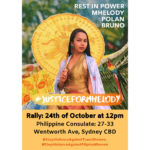‘Dying Declarations’: ‘It was………..’

We’ve all seen it in movies – a killer has struck and, just before dying, the victim utters a clue that is instrumental in solving the whole mystery.
This is known as a ‘dying declaration’ and often proves to be an essential part of the plot.
But what about real life? Is a dying declaration admissible as evidence in court?
Hearsay evidence
‘Hearsay evidence’ is possibly the most misunderstood area of evidence law.
Hearsay is essentially a form of indirect knowledge – where a witness claims that someone else gave them information that may be relevant to solving a crime.
Hearsay evidence is usually not allowed to be used in court. Rather, the maker of the original statement must be available to give this testimony in court, or that information will be deemed inadmissible.
In the case of the dying declaration, this would be fatal (pardon the pun) because the person who made the statement is dead. This means that any evidence of what the dying person said would be inadmissible because of the hearsay rule.
Exceptions to the rule against hearsay evidence
However, there are a number of exceptions to the ban on hearsay evidence being used in criminal proceedings, and the dying declaration is one of them. Indeed, dying declarations have actually been admissible in court for centuries.
Why is it an exception?
Dying declarations came to be an exception because of theological reasons – specifically, it was assumed that a person would not want to ‘meet their maker’ with a lie in their mouth. Because of this, the words of a dying person were presumed to be truthful.
But in a secular society like Australia, where not everyone believes in God, the theological justification is tenuous. Many people are atheists, agnostics, or have completely different belief systems altogether. Courts have therefore discussed the relevance of individual ‘dying declarations’ in the context of ‘non-believers’.
Before the mid-1990s, judges would examine the personal beliefs of the deceased in order to determine whether or not the dying declaration would be admissible.
But now, dying declarations are admitted regardless of the religious beliefs held by the person who made them.
The dying declaration is now acceptable because, as stated in R v Golightly (1997) 17 WAR 401, “in the face of death, there is a motive to die with truth, not with untruth.”
This relatively recent Western Australian case redefined the jurisprudence surrounding the legal rule, and has been followed in other Australian states.
The facts of the case were that Mr Golightly was charged with murder. The brother of the deceased man heard him cry out in pain and say, “John Golightly shot me.” He died within minutes of making that declaration.
In Golightly, Justice Owen listed five criteria that must be satisfied for a dying declaration to be admissible:
- The maker of the dying declaration must be dead;
- The trial must be for the deceased’s murder or manslaughter;
- The statement must related to the cause of the deceased’s death;
- The deceased must have been a competent witness; and
- The deceased must be under a “settled hopeless expectation of death”
What constitutes a ‘statement’?
A wide range of declarations may be admissible, as long as they meet the above five criteria.
The case DPP v Debs & Roberts (2002) involved two men who were accused of murder.
One of accused men objected to the admission into evidence of the words “get them” that were uttered by the deceased just before death. The basis for the objection was that the phrase was a prospective direction rather than a retrospective ‘declaration’.
The prosecution wanted to use the phrase to show there was more than one attacker. The court held that the phrase was admissible because they satisfied the criteria for a dying declaration, regardless of the fact that it was not in the past tense.
So it’s safe to say that ‘dying declarations’ are indeed a legal principle – although they are far less likely to pop up in the courtroom as they are on TV.






